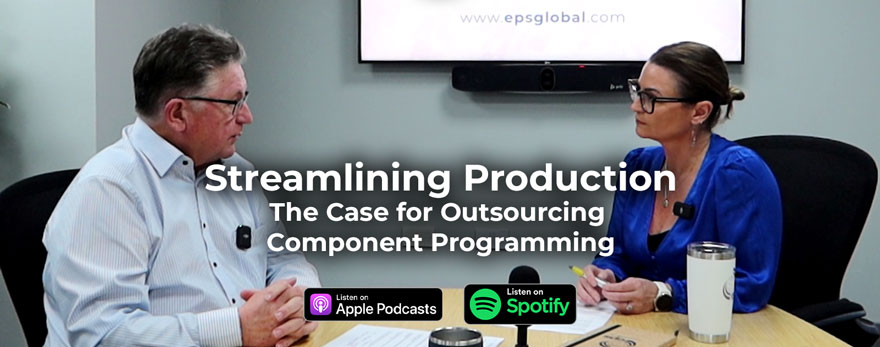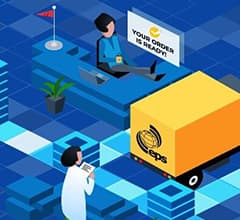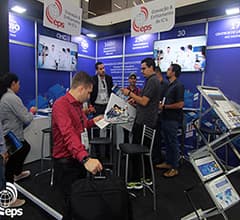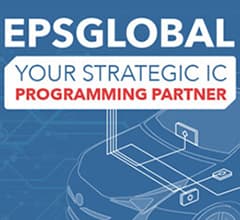Home > News & Blog > Component Packaging
Streamlining Production: The Case for Outsourcing Component Programming

In this episode, our CMO Ciara McCarthy speaks with Mick McCarthy, COO of EPS Global, to discuss the advantages of outsourcing component programming versus handling it in-house at ICT. Mick explains how outsourcing simplifies production processes, reduces bottlenecks, and increases throughput on expensive surface mount lines. He highlights the complexities of in-house programming, including the need for specialized equipment, software, and quality control systems, and contrasts this with EPS Global’s streamlined, quality-focused approach.
With 22 programming centers worldwide, EPS Global offers manufacturers a way to improve efficiency, ensure traceability, and reduce costs. Mick also provides practical advice for manufacturers considering a shift to outsourcing, emphasizing the importance of evaluating production bottlenecks and leveraging EPS Global’s 25 years of expertise. This episode is packed with valuable insights for anyone in the manufacturing industry looking to optimize their operations.
Transcript of The Evolution of Tape and Reel Packaging in Modern Manufacturing
Ciara: Welcome to The Critical Lowdown. Today I'm here with Mick McCarthy, the Chief Operations Officer at EPS Global, and we're here to talk about outsourcing your component programming versus programming at ICT or in-circuit test.
How does outsourcing component programming and packaging impact production line efficiency as compared to doing it at ICT?
Mick: The whole idea of high-speed component placement and line yield is to reduce the complexity of the processes on your line and increase throughput. A surface mount line is a very expensive piece of equipment—three, four, five million dollars—with various processes built in, and it's supported by expert personnel. When we talk about taking component programming off the line, it's the test engineering management group that gets affected.
Their job is to manage the test process, which involves managing both the test algorithm, which is a really complex algorithm, and the programming algorithm. When you're programming at ICT, that's an extra resource. What we suggest to those people is that by removing the programming activity from ICT, it simplifies their life.
Ciara: Do you have some funny little stories about that?
Mick: Well, maybe another day. It basically simplifies their life if they just have to deal with the algorithm that tests the components as they're mounted on the board. By making the decision to move component programming away from ICT, it means that somebody like us pre-configures the component so that when it's placed on the board, it's immediately live. It has everything it needs, with the intelligence of the firmware already embedded into it. The board, in many cases, lights up quicker.
Beyond eliminating the need for a programming algorithm, it helps the board communicate quicker with the bed of nails and the ICT tester. That's one of the big advantages, particularly for longer programming times—anything over 10 seconds is considered significant.
If you're getting a thousand boards through your line, you probably have to significantly increase the number of testers in your line because ICT is always a bottleneck. These testers cost about a million dollars each. If you need to put four testers into the middle of your line, besides creating the bottleneck, it's an extremely expensive activity. It also means you need to replicate the test beds themselves. This becomes a very expensive process to increase your line throughput.
However, if you can manage your test algorithm in a reasonable time period that works with the beat rate of your line, you significantly increase your throughput.
Ciara: You mentioned a bed of nails. Could you give us a quick explanation of what this is?
Mick: That's a testing fixture that sits down on top of the circuit board after the components have been mounted. It makes physical contact with all of the major components to be tested. The system runs through checks to ensure these devices have been mounted properly, that there are no raised components, and that all of the solder joints are working properly. It's an expensive piece of equipment that's custom-made for each individual version of the board.
Ciara: What kind of resources would you need if you decide to do programming in-house?
Mick: If you're going to do your own programming in-house or online side, you need to decide what equipment you're going to program it on. You need all the correct adapters, which are specific to the chip size, type, and layout. You need to manage all your adapters and have software to control that process.
Where many people get bad results from programming themselves offline is when the actual programming process isn't well controlled. The main business of most contract manufacturers or tier-one automotive companies is chip shooting and getting a board to a testable stage that ultimately passes functional test. By deciding to do off-board programming, you're adding more complexity to your business. You need to control all the software revisions of the chips you're going to program.
If I can draw a parallel to the types of resources we employ in our business: First, our ERP system is based around component programming and component prep. The most important thing is that the IC gets programmed to the correct revision. You're starting with a blank part number and ending up with a different part number because we're reconfiguring the chip by inserting firmware.
In our programming centers worldwide, we use the same software. We have operations managers who oversee operations and have specific programming experience. We need quality managers, particularly important in automotive and medical industries where quality standards are very exacting. We get audited regularly by customers to ensure compliance and maintain necessary certificates.
We have production controllers to plan production and utilize our resources efficiently, plus supervisors and operators who manage day-to-day component production. We make all our own handlers, designed and built in Brno City in the Czech Republic, and they're very integrated.
Comparing our handlers with others in the market, we do all our 3D coplanarity checking in line, automated optical inspection in line, and laser marking in line. We take the blank device from its packaging, present it to the programming heads, inspect after programming to verify we haven't damaged the chip, with log files proving the chip's integrity. We then laser mark it, inspect it automatically, put it into tape automatically, and seal and reel the carrier tape.
It's a simple, integrated process from our perspective that rarely causes quality problems.
Ciara: It sounds like it's all based around quality, traceability, and everything is tracked?
Mick: Yes.
Ciara: So there's quite a lot of resources involved between machinery and staff to manage that machinery and to manage the process and the ERP system that provides this traceability and quality. So that's what's required if you want to do this yourself.
Mick: Within our programming centers, we have a customer-facing team that interprets customer requirements, which can be complex and time-critical, and transmits that into our ERP system so our production group is flagged to produce the correct devices on time. Our quality team oversees the entire process.
We have special capabilities in label production, traceability, and ensuring device out-of-packet time is monitored because these are moisture-sensitive devices. Our systems are designed to manage delicate components, get the right version of software into them, package them properly, and ensure they're correctly labeled for shipping to clients.
Ciara: For manufacturers considering a shift to outsourcing their programming or taking the programming offline and allowing EPS Global to provide this service, what key steps should they take to evaluate and implement the pre-assembly programming?
Mick: Contact our local representative, but they should review their production process and identify possible advantages. By looking at bottlenecks in their production process, they might see opportunities to increase throughput, line yield, or test capability by working with us.
We have 22 programming centers worldwide, all located in areas of volume manufacturing. We've deliberately chosen these areas, and we can safely say we're covering most regions where this work happens. Our 25 years of experience working with production schedules can help improve their local situation and get more value from their plants.
Ciara: So I guess the message here is to use EPS Global's vast experience and resources to save time and increase efficiencies and reduce costs?
Glossary of Terms
- Tape and Reel - A packaging method for electronic components where parts are sealed in a carrier tape and wound onto a reel, designed for automated pick-and-place operations.
- Pick-and-Place - The automated process of picking up electronic components and placing them precisely on a printed circuit board during assembly.
- Custom Tape - Specialized carrier tape manufactured to accommodate components with non-standard sizes or shapes, such as connectors or transformers.
- Wafer Taping - A specialized process for packaging semiconductor components directly from wafers into tape and reel format, handling components as small as 300 microns squared.
- Discrete Taping and Reeling - The process of packaging individual, non-programmed components such as die-cast parts, metal parts, and connectors into tape format.










